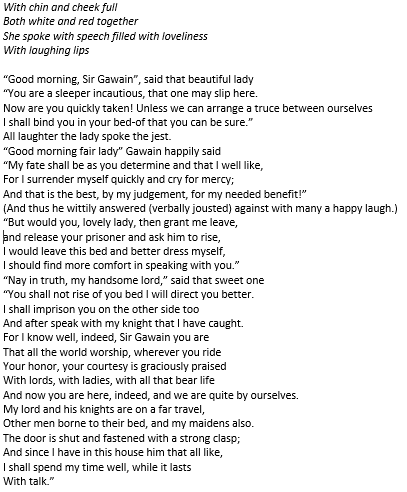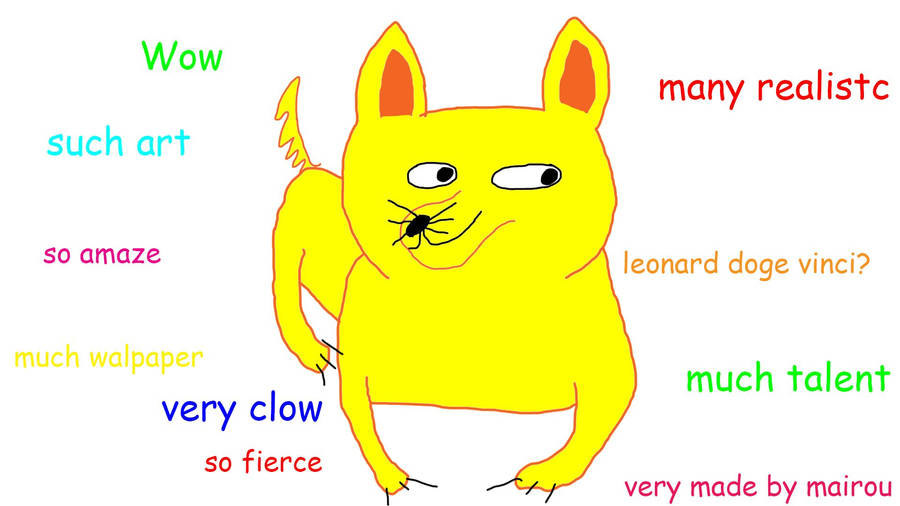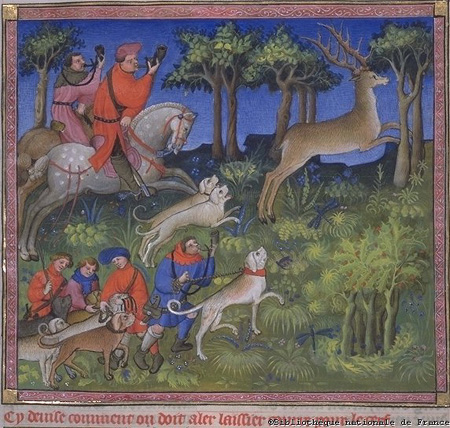[This post, part of an effort to merge our undergraduate and graduate blogs, was written in response to an essay prompt for Kathryn Kerby-Fulton's undergraduate course on "Chaucer's Biggest Rivals: The Alliterative Poets." It comes from the former "Medieval Undergraduate Research" website.]
In a way, any translation of Sir Gawain and the Green Knight is a minor miracle. Translating anything is difficult because the translation must attempt to make good logical sense while simultaneously capturing the spirit of the words. This is often difficult because the connotations behind each word are different in the language that the text is being translated into. Translating Middle English is particularly difficult because many of the words that the original texts use have a plethora of possible meanings. Middle English was also written in a time when dictionaries and writing guides were not readily available for all writers; therefore translation is further complicated by inconsistent spelling. On the same page it is not uncommon to find two or three spellings of the exact same word. Without spelling books words were often written phonetically, which led to further variation in writing as individual authors spoke different dialects. The difference in dialects is comparable to the different regional variations of speech in the United States. Imagine if a Bostonian and a Southern Californian were both to write and spell exactly as they spoke: their writing would share common words, but some words would sound and look completely different. It is therefore, difficult to even identify the best rewriting of particular words, let alone capture the connotation of the line or piece as a whole. Poetry presents a challenge in any language. Its special use of word play is often filled with subtleties that even an astute fluent reader can miss. In translating poetry the tools of alliteration, rhyming, as well as word play through the use of homonyms and homographs is often lost. Therefore any translator attempting to relate the epic poem of Sir Gawain and the Green Knight faces many difficulties, and each translator will have their own individual spin.
Marie Borroff’s translation is the one most commonly found in Norton Anthologies and is widely viewed as one of the best translations. However, after reading Sir Gawain, I would like to tease out some difference between her text and the original as I understand it. Below is a side by side comparison of my own translation (on the right) and Borroff’s translation (on the left) of Part I lines 1204-1236.


One of the first things I noticed was that this rather steamy scene was significantly censored and edited so that the lady was portrayed in a more playful rather than sexually aggressive light. For example, instead of translating “I schal happe yow here þat oþer half als” as “I shall imprison you on the other side too” and choosing “I shall hem and hold you on either hand,” Borroff is closer to directly translating the words themselves, but misses the truly sexually explicit imagery that the words imply. Her chosen adjectives go with the less aggressive or unsettling meanings, as well. For instance, she has chosen to take the word “vnslyȝe” in “Ȝe ar a sleper vnslyȝe, þat mon may slyde hider” to mean “slack”. However an alternative meaning of the word is “incautious”, which warns the reader that Sir Gawain must be very cautious in this next encounter. Interestingly, on further examination Sir Gawain is similarly portrayed in a gentler light as he is described as gentle and jesting, “Thus jested in answer that gentle knight,” instead of being characterized as more war-like, “And thus he wittily answered (verbally jousted) against with many a happy laugh”. I have chosen to translate the word “bourded” in this way because of the presence of the word “aȝayn” which means against. Jesting and verbal jousting are often the same thing, however I felt like the word “against” together with “jousting” created a war-like feeling appropriate to a knight being tested.
As the differences in translating the line “And þus he bourded aȝayn with mony a blyþe laȝter” reveals, even some of the best translations cannot capture some of the word play that is occurring. “Bourded” seemed to be a variation of the word “bourden”. “Bourden” could mean exactly what Borroff suggests, according to the Middle English Dictionary, it could very well mean “to joke, jest, mock”. However the MED also gives a second possibility as “to joust,” or even more specifically, “charge (a boar) with a spear”. Clearly the second possibility cleverly links Gawain’s challenge in the bedroom with the lady, to Lord Bertilak’s ongoing hunt in the forest as one of the animals he hunts is a boar.
Another example of when the translation must unfortunately shed itself of the word play occurring is in the line “Al laȝande þe lady lauced þo bourdez”. The word “lauced” according to the glossary in the back of Gillespie, Glasscoe, and Swanton’s The Poems of the Pearl Manuscript could mean to “utter, speak” but it also has the alternate meaning “loosen, break, burst, undo, and open”. The use of this homograph helps create the sexual atmosphere of the scene. Even though the lady does not actually loosen or undo anything, the clever play on words, draws the reader’s eyes to the implicit sexually aggressive nature of the scene as a whole.

Aside from the sexual nature of the scene, which Borroff tries to make family friendly, her usage of punctuation is particularly interesting. In part, I believe that this is due to the fact that Borroff is not directly translating the text, but is attempting to make it flow in modern day English. Despite her careful use of archaic words, Borroff gives a very readable text to the modern reader. However, by slightly changing the punctuation of her text, Borroff is placing emphasis on different ideas within the passage. For example, by placing an exclamation point after “I am well content!” instead of the comma used in the original, Borroff Is stressing the knight’s content. While this may seem like a minor issue, the stress on the knight’s content makes him sound more confident and at ease than in the original. In the original he is obviously uncomfortable as he claims that he needs a certain outcome to occur, “Me schal worþe at your wille, and þat me wel lykez, For I ȝelde me ȝederly, and ȝeȝe after grace, And þat is þe best, be my dome, for me byhouez need!’”.
Therefore, while Borroff provides the world with an introduction to the story of Sir Gawain by translating it and thereby making it more approachable, her translation can be and should be critiqued. First, for some of the choices she herself makes, like the choice to downplay the sexual nature of the scene; and secondly, because of the nature of translation itself. No translation, however masterful, can capture all of the intricacies of the original.

Mercedes de la Rosa
University of Notre Dame

